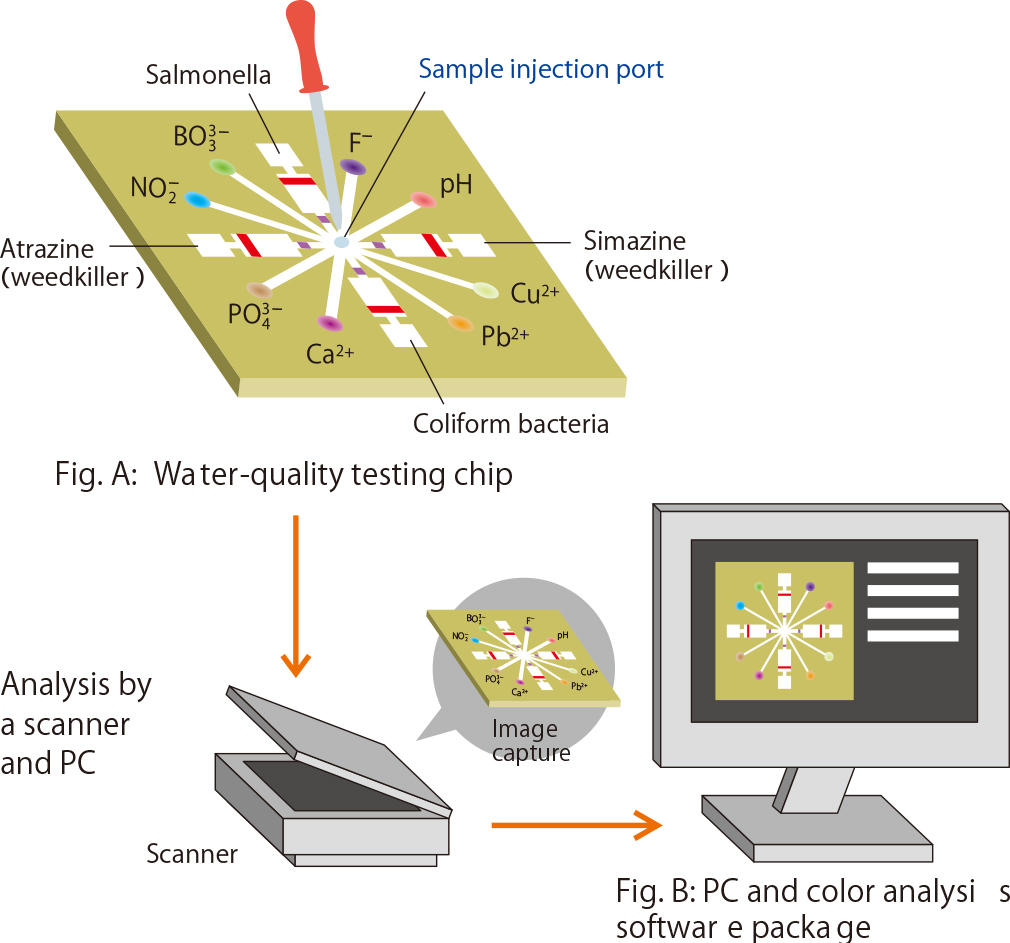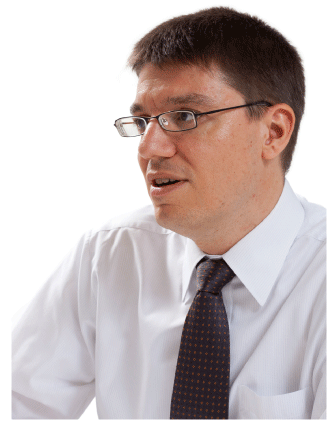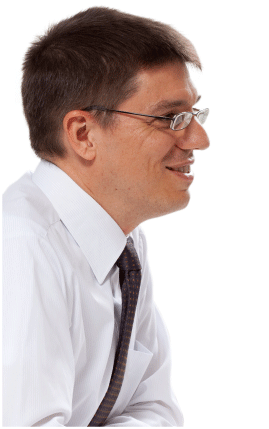- Home
- New Kyurizukai
- New Analytical Chemistry
from Keio's Faculty of Science and Technology
New Analytical Chemistry
from Keio's Faculty of Science and Technology
Medical and environmental sensing chips
that can be made with an inkjet printer alone.
Japan is complete with an excellent research-encouraging environment
Mr. Citterio is devoted to the development of handy paper-based sensors that anyone,
not only specialists, can handle with ease. Eight years have passed since Mr. Citterio,
born in Zurich, Switzerland, came to Japan to engage in research work.
He praises Japan as an attractively fertile soil for research pursuits thanks to strong bonds among researchers as well as an excellent research environment relatively favored with both ample budgets and advanced facilities.
Citterio, Daniel
By creating and combining functional materials (dyes, polymers, etc.), his research work focuses on the development of (bio) chemical sensors for application in industrial, medical, and environmental analysis. Born in Zurich, Switzerland, he graduated from the Department of Chemistry of the Swiss Federal Institute of Technology (ETHZ) in 1992 and obtained his Doctor degree from the same school in 1998. After postdoctoral research at Keio University, he became a research associate at ETHZ. Through postgraduate studies, he obtained a Masters degree in Intellectual Property and joined a Swiss chemical manufacturer as a patent attorney. In 2006, he returned to Keio University, were he became a tenured Associate Professor at the Department of Applied Chemistry in 2009.
Introducing Researchers
Featured in this issue is Associate Professor Citterio, Daniel, who focuses on the development and practical implementation of a handy sensing chip fabricated by the inkjet printing technology.
Creating Paper-based Sensors Using Inkjet Printer
Development of handy sensing chips for medical and environmental uses
The condition of one’s health can be judged by simply putting a drop of saliva or urine on a piece of paper and observing a color variation. Or the degree of river pollution can be determined from a small quantity of river water . . . The development of such handy sensing chips is now in progress. All that is required to create the sensing chip is paper and an inkjet printer. We listened to Dr. Citterio who addresses the development of innovative, highly useful sensors by combining existing technologies with new “chemical sensing inks” specifically designed for this purpose.
Fantastic paper-based sensors . . . No special equipment, not even a power supply, is required to use them!
“What I’m focusing on are chemical sensors and biosensors that can be carried and handled by anyone and anywhere, making measurement quite easy,” remarks Associate Professor Citterio.
Among familiar examples of chemical sensors are litmus paper for pH measurement and gas leak detectors . Furthermore, biosensors make use of biomolecules such as enzymes and antibodies to selectively recognize target substances. One well-known example are pregnancy test kits. What Dr. Citterio aims to develop are handy sensing systems that will allow instantaneous visual recognition, like that of a color variation on litmus paper
“In particular, I’d like to create handy sensing systems for medical and environmental applications. When it comes to health management and medical diagnosis, the sensing system will allow you, while at home, to check urine, saliva or blood for protein, blood sugar and hemoglobin conditions, for example. Regarding environmental applications, the system will make it possible to easily check drinking or lake water for pH value or for the existence of contaminants such as lead, cadmium and other heavy metals as well as nitrite, arsenic, herbicides and pesticides. Effective combination of already established sensing technologies and their adaptation towards new inkjet printable materials is my approach to the development of easy-to-use and highly practical systems.”
With this approach in mind, Dr. Citterio decided to employ “paper” as the sensor substrate – filter paper made of cellulose fibers. He thought paper would be ideal as it is available anywhere easily and for a low price, lightweight and handy to carry, mailable, easily storable, and can be burned or discarded after use. Presently available systems for medical and environmental analysis are of a large scale, their use requiring an air-conditioned laboratory and cooling equipment like a refrigerator. But a paper-based system would eliminate the need for such equipment or even a power source. This means great advantages when used at home and at fieldwork sites and in developing countries where medical facilities are poor or insufficient. What’s more, it can be used easily even under emergencies.
“In the world of chemistry, paper has been used since ancient times. Chemicals can be fixed to it and it’s capable of wicking a solution by means of the capillary action phenomenon. One fine example is the established technology known as paper chromatography used to separate chemical substances by virtue of these filter paper characteristics.
The amount of reagent consumption would be minimized if various kinds of tests can be conducted by dropping only one drop of sample on to a small piece of paper. Given some reagents for example based on antigen-antibody reactions are costly, it is very important to reduce reagent consumption by reducing the chip size itself.

Handy medical/environmental sensing chip
The use of this chip allows anyone to conduct medical tests with only a small amount of body fluid (saliva, blood, or urine) and to check wastewater or river/lake water quality – at low costs, promptly and easily.
Making chips with one single inkjet printer
In reality, several research groups recently began pursuing the method of using paper as sensor material. However, the originality of Dr. Citterio’s team lies in the use of an inkjet printer based on the piezo method (a method of jetting out ink by means of a piezoelectric element when voltage is applied to the print head).
“Since more than ten years ago, research efforts have been increasingly made on Micro-TAS (Micro-Total Analysis Systems) – devices for the analysis of chemicals by combining microscopic flow-channels, reaction chambers and mixing chambers on a minute chip. Glass and plastic chips have been used until recently. In 2007 Professor Whitesides of Harvard University proposed paper chips as a cheaper and easier solution.
In association with paper, Dr. Citterio’s team set their eyes on an inkjet printer capable of jetting any desired controlled amount of ink. Today, inkjet printing has grown into a highly generalized technology, finding wide applications not only for paper printing, but also for largesize color display films through to the production of microscopic items such as semiconductor substrates. This advantage makes the inkjet printer very attractive, Dr. Citterio says.
“To make a chip, you basically put the required reagents in the ink cartridge and print onto paper. Then, simply use a pipette to apply a sample like blood or urine. Soon a reaction occurs. Besides, we are not only able to print chemical reagents, but we also create microfluidic channels on the chip using the inkjet printer. It will be highly cost-saving if we can perform the entire chip-making process with a single printer, you know.”

How to make a medical/environmental sensing chip
The sensing chip is made using the following processes ; (1) Soak the filter paper in a solution of polymer (polystyrene) for coating, making it hydrophobic ; (2) Use an inkjet printer to discharge an organic solvent (toluene) and make a channel. Polymer on the part to which toluene was applied is dissolved, thereby creating a hydrophilic channel ; (3) Then use the inkjet printer to print the sensing ink (test reagent) on the test area at the end of the channel.
The keys: the sensing ink and chip’s microfluidic channel design
The greatest challenge involved in the chip-making process is the development of multiple functional chemical and biochemical sensing inks. For this purpose, the creation of chemically functional materials in nanoparticulate form is essential.
“With ordinary printer nozzles, there are limitations to the liquid viscosity and particle size that can be discharged. Also, you must ensure that the normally water soluble reagents are not washed away by the flowing sample, but stay firmly on the test area so that color change occurs uniformly, in a repeatable manner. So it becomes important to exert ingenuity such as the use of small polymeric particles in the ink to prompt the reagent adsorption onto the paper.
Although we still have a number of chemical and physical problems to be solved, it would be fantastic if in the future we could develop a sensing system with which we can perform everything with an ordinary printer we’re using at home.”
Another challenge Dr. Citterio is intent on is the design of the microfluidic channels to be patterned on the paper substrate – only 500μm in width.
“We are making the flow-channels and sensing areas by printing a pattern on a piece of filter paper that has been dried after being soaked in a solution of a highly hydrophobic polymer known as polystyrene. Here we use toluene as the ink, an organic solvent that dissolves polystyrene. In other words, only the flow-channel and sensing area parts become hydrophilic. Chemical and biochemical sensing inks are printed onto those sensing areas to make the final chip.
If we succeed in making a good pattern, it will be possible to have one single piece of paper accommodate multiple test items.”
Currently Dr. Citterio is also studying a method of drawing a pattern using a material that is more environmentfriendly than toluene, accelerating the research work aiming for completion and launch within a few years’ time.

A handy system anyone can use anywhere
When making a sensing chip, you print the sensing inks (test reagents) for your targeted test items such as Salmonella and ingredients of weedkillers (Simazine and Atrazine) on the chip. Then, by simply placing one drop of the sample into the sample injection port, reactions will occur in the respective areas, making it possible to measure multiple test items simultaneously (Fig. A). This sensing chip is not only suitable for visual judgment, but it is also capable of quantitative analysis if used together with a scanner. Systemizing it by combining with a PC, you can create an easily portable, epoch-making sensing system (Fig. B).
Interview
Listening to what Associate Professor Citterio, Daniel says
Coming to Japan to broaden my horizons in life
When did you come to Japan?

My first visit to Japan was in 1996 when I was a doctor course student at the Swiss Federal Institute of Technology in Zurich (ETHZ). At that time I had an opportunity to participate in a joint project and belonged to the Chemical and Biosensor Laboratory at the University of Tokyo’s Graduate School of Science, staying for three months. With universities in Europe, students in natural sciences usually find employment after completing a doctor’s course and then pursuing postdoctoral studies overseas for at least one year. Many of my fellow students liked to study in the United States, but I didn’t want to go there. This was because, rather than for the sake of research only, I also wanted to broaden my horizons in life. In other words, I wanted to take up new challenges in a land where culture and language are totally different. So I made up my mind to study as a postdoctoral fellow in Japan, the destination I had visited as a doctor course student. During my first visit to Japan, I found this country very intriguing. At first sight, Tokyo appeared no different from big cities in the West. After talking with its people, I felt that it had a culture totally different from Western cultures. What surprised me, for example, was the fact that vertical human relationships in labs between superiors and subordinates and between senior and junior students were absolute. Not to mention food and people’s lifestyles, everything I saw and experienced was fresh and surprising indeed. To tell the truth, during my first visit to Japan I had an opportunity to visit Keio University for only one day. On that occasion I paid a visit to Professor Suzuki’s lab, to which I belong now. I learned that Professor Suzuki’s lab is engaged in research close to that of mine. Finding that students there were all open-minded and easy to communicate with, I had a good impression of Keio. It was in March 1998 that I revisited Japan as a postdoctoral fellow of Keio University. My initial plan was to stay for one year. But as I got accustomed to my research life in Japan, I began to think it would be a waste of precious opportunity if I left Japan as initially planned. Our lab’s atmosphere was so comfortable that I postponed my return again and again. As a result, I had stayed in Japan for four and a half years in total.
Did you acquire your Japanese language ability in those days?
Yes. In my early years I could hardly speak Japanese, which put me in trouble even for shopping and other daily matters. But my Japanese gradually improved thanks to once-a-week Japanese lessons from a private teacher and daily communication with students on the campus. The most effective learning above all was through communication with students. But I was amazed at Japanese students’ very poor English-speaking ability. So at the beginning, we had to talk by means of writing, myself in English and Japanese students in Japanese though kanji characters still remain my weak point even now. (laughter)
Later, in 2002, I returned to Switzerland and began to work as an assistant professor at a university. Meanwhile, I became interested in patents by that time because our Keio lab had obtained several patents. So I acquired a patent attorney qualification by entering a university again to study. Formerly the generally accepted idea about research scientists was that they should devote themselves to research, staying away from worldly matters such as obtaining patents. But things are different today. Knowledge of patents is very important for us to make the most of our own research achievements in society.
Armed with these careers, I once found employment with a Swiss chemical maker, but left this company a year later and returned to Japan.
Japan has a favorable environment for researchers
Why?
I had long enjoyed a life steeped in unrestricted research activities, conducting experiments at university labs and writing theses. But the moment I joined the company, such lifestyle was lost, which caused me to entertain anxiety about my future. I thought I was a researcher type after all.
The fact is, at that time I was not so serious about returning to Japan. But there were two factors underlying my decision to revisit Japan. Firstly, I could communicate in Japanese by that time, which made me feel that I would have much less difficulty in staying in Japan again. Secondly, I had good impressions of the four and a half years at Keio during my previous visit. In the meantime, Professor Suzuki was kind enough to invite me to participate in a new project. I thus came back to Keio University’s Faculty of Science and Technology in 2006 as a non-tenured associate professor. From the academic year 2009, I became a full-time associate professor.
At that time I was surprised to see many more overseas students on the campus than before. It must be an indication of progressive advance in internationalization.
From 2007 on I focused on research into paper-based chips using the inkjet printer. I think Keio is complete with a superb environment for researchers.
You mean it’s a favorable environment for researchers?
When we propose a research project and it is accepted, the university offers an adequate support environment and we can proceed with the project almost unrestrictedly. This is a great merit.
Things seem to be changing a bit these days. Even so, I think Japan still offers an environment in which research budgets are available relatively easily. I also notice strong bonds existing among researchers like Professor Suzuki. They all value mutual human connections, which is good. For example, even when you want to know about something that is outside of your own specialty field, you can consult a specialist of that particular field through a network – a great environment.
On the other hand, Japanese students are now undergoing difficulties in finding employment due mainly to the continued recession. There are quite a few students who wish to study overseas but are forced to give up, giving priority to finding employment. It’s a very regretful situation.
Recently we hear that students in general are becoming backward-looking when it comes to studying overseas. What do you think?

In my view, they actually have motivations and opportunities for studying overseas. But the prevailing trend today is that they are anxious about securing employment as soon as possible. Meanwhile, there are those students who have changed their priority to studying overseas, the opportunity being exposure to the outside world by participation in international academic conferences. To study abroad, they of course need to jump over the hurdles of English language ability. I’d like to see more and more students gain self-confidence by attending international conferences and so on. Speaking of my own experience, I had hard time to learn Japanese but successfully learned Japanese technical terminology by positively attending technical seminars and academic society meetings. I’d advise them to avail themselves of such opportunities. Therefore, I am offering a lecture series where students can practice presentations in English, similar to an international scientific meeting.
Why did I choose to become a researcher?
By the way, is your name Italian?
Yes. This is because my ancestors immigrated from the northern part of Italy to Switzerland. My father was born in Switzerland while my mother had two nationalities: German and Swiss. My mother tongue is German.
Incidentally, as a small boy I was not particularly interested in becoming a scientist. Rather, I wanted to become a pilot but gave up the dream because of weak eyesight. Somehow I was good at foreign languages (English, French, Italian and Latin) at school, which made my teacher recommend me to major in foreign languages in the future. Though I undoubtedly liked foreign language study, I didn’t think I would choose foreign language study itself as my profession.
What I am today as a researcher may partially be the influence of a high school chemistry teacher who lived in a neighboring condominium. I still remember him telling me many things about chemistry while giving me a ride to school. At one time I was absorbed in a chemical experiment kit for junior high school students. Due to failure of an experiment one day, I discolored the wallpaper of my room into brown. (laughter) Anyway I loved experiments.
You like to use your own hands to create something, don’t you?

Yes, I do. In fact, I’m also good at cooking. In a way cooking is similar to chemical experiments, you know. In Japan I’ve been living in the Hiyoshi area. Living a single-life, when I have time I often invite friends or some of my students and treat them to dishes of my own cooking. Though Japanese dishes are too complicated to cook, cheese fondue and the like are my favorite items to cook. Since I like to move not only my hands but also the whole body, I often enjoy outdoors on days off – activities like cycling, skiing and hiking. I was surprised to find few young Japanese people taking up hiking as outdoor recreation. Given superb scenic attractions in Japan, I’d like more and more students to enjoy what nature has to offer. I recover vitality needed for research work through such outdoor leisure activities.
Just a word from . . .
A student : Daniel-san is frank and easy to communicate with. All of us follow him like one of our seniors. Not only does he allow whatever we like to challenge, but also he is always willing to give advice. He is a truly reliable teacher.
(Reporter & and text writer: Madoka Tainaka)


